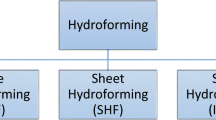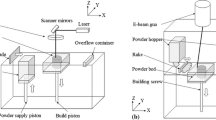Abstract
Bulge formation occurs in drawing with light reductions and large die angles. Reports concerning its effect on strain inhomogeneity in axi-symmetric drawing are limited. In this study, bulge formation is characterized by the occurrence of outward radial velocities in the finite element analysis. Strain distributions, including axial, radial, circumferential, shear, and effective strains, were analyzed to explain the effect of bulge formation on strain inhomogeneity. Hardness tests for the drawing experiment were conducted to verify the findings of the FE simulation. Optical microscopy of the microstructures produced by drawing under both a near homogeneous condition and a bulging condition was performed. The results indicate that bulging causes a peak in the axial strain distribution near the drawn workpiece’s surface, leading to a slight fall-off of effective strain on the surface. The peak is caused by the excessive redundant deformation of a local reversion from compressive to tensile axial strain. The strain peak is greater when drawing with light reductions and large die angles and becomes more noticeable with small strain-hardening exponents or large friction factors. Bulge formation also causes fibrous flow lines near the surface of the drawn workpiece.
Similar content being viewed by others
References
Chin RK, Steif PS (1995) A computational study of strain inhomogeneity in wire drawing. Int J Mach Tools Manuf 35:1087–1098
Överstam H (2006) The influence of bearing geometry on the residual stress state in cold drawn wire, analysed by the FEM. J Mater Process Technol 171(3):446–450
Vega G, Haddi A, Imad A (2009) Investigation of process parameters effect on the copper-wire drawing. Mater Des 30(8):3308–3312
Celentano DJ, Palacios MA, Rojas EL, Cruchaga MA, Artigas AA, Monsalve AE (2009) Simulation and experimental validation of multiple-step wire drawing processes. Finite Elem Anal Des 45(3):163–180
Sadok L, Luksza J, Majta J, Skolyszewaki A (1994) Analysis of inhomogeneity of mechanical properties in stainless steel rods after drawing. J Mater Process Technol 45:293–298
Majta J, Luksza J, Sadok L (1992) The estimation of mechanical properties distribution in plastic working products: example for the drawing. J Mater Process Technol 34:389–396
Sadok L, Luksza J, Packo M, Burdej M (1994) Analysis of the strain state in the stainless steel rods after drawing. J Mater Process Technol 45:305–310
Riendeau MP, Mataya MC, Matlock DK (1997) Controlled drawing to produce desirable hardness and microstructural gradients in alloy 302 wire. Metall Mater Trans A 28A:363–375
Cetlin PR, Silva AP (1994) A compartion of deformation factors in the drawing of round sections bars. Trans ASME 116:574–575
Aguilar MTP, Correa ECS, Silva RF, Cetlin PR (2002) The evaluation of redundant deformation factors in axi-symmetric bar drawing of austenitic stainless steel. J Mater Process Technol 125–126:323–325
Hasani GH, Mahmudi R, Karimi-Taheri A (2010) On the strain inhomogeneity in drawn copper wires. Int J Mater Form 3(1):59–64
Muskalski Z (2012) Effect of Reduced Redundant Strain on the Properties of Drawn Wires. Steel Research International, Special Edition: 14th International Conference:459-462
Yoshida K, Doi K (2014) Improvement of Ductility of Aluminum Wire for Automotive Wiring Harness by Alternate Drawing. Procedia Eng 81:706–711
Coffin JLF, Rogers HC (1967) Influence of pressure on the structural damage in matel forming process. Trans ASME 60:672–686
Johnson RW, Rowe GW (1967) Bulge formation in strip drawing with light reductions in area. Proc Inst Mech Eng 182:521–530
Rubio EM, Marin M, Domingo R, Sebastian MA (2009) Analysis of plate drawing processes by the upper bound method using theoretical work-hardening materials. Int J Adv Manuf Technol 40:261–269
Hosseinabadi HG, Serajzadeh S (2011) A coupled stream function-finite element anaysis for wire drawing processes. Int J Adv Manuf Technol 57:917–926
Shan X, Qi H, Wang L, Xie T (2012) A new model of the antifriction effect on wiredrawing with ultrasound. Int J Adv Manuf Technol 63:1047–1056
Avitzur B (1983) Handbook of metal-forming process. John Wiley & Sons, New York
Hosford WF, Caddell RM (2007) Meral Forming, Mechanics and Metallurgy, 3rd edn. Cambridge University Press, UK
Schey J (1983) Tribology in Metalworking. American Society for Metals
Hirsch TK, da Silva Rocha A, Menezes Nunes R (2014) Characterization of local residual stress inhomogeneities in combined wire drawing process of AISI 1045 steel bars. Int J Adv Manuf Technol 70:661–668
Author information
Authors and Affiliations
Corresponding author
Rights and permissions
About this article
Cite this article
Lin, HS., Hsu, YC. & Ke, CC. Effect of bulge formation on strain inhomogeneity in axi-symmetric metal drawing of light reductions. Int J Adv Manuf Technol 81, 53–65 (2015). https://doi.org/10.1007/s00170-015-7196-x
Received:
Accepted:
Published:
Issue Date:
DOI: https://doi.org/10.1007/s00170-015-7196-x




